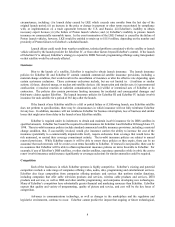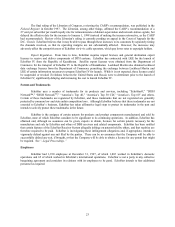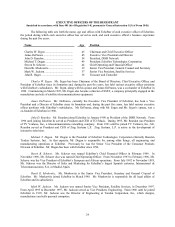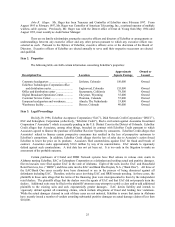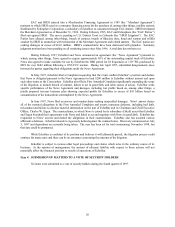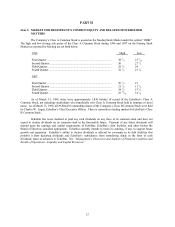Dish Network 1997 Annual Report Download - page 19
Download and view the complete annual report
Please find page 19 of the 1997 Dish Network annual report below. You can navigate through the pages in the report by either clicking on the pages listed below, or by using the keyword search tool below to find specific information within the annual report.17
control approvals) are obtained, EchoStar would have the right to use a total of up to 17 transponders on EchoStar III.
There can be no assurance that these approvals will be obtained.
EchoStar also has licenses covering 21 channels at 119° WL. Pursuant to these licenses, EchoStar is using 11
of the 16 transponders on EchoStar I and ten of the 16 transponders on EchoStar II to transmit DISH Network and
Satellite Services programming to the continental U.S. from the 119° WL orbital slot. In July 1997, EchoStar filed a
request for an STA to use the 11 channels assigned to Tempo at the 119° WL orbital location, on the grounds that
Tempo, while it launched a satellite to that location in March 1997, has not yet started providing service. Tempo has
opposed this request on several grounds, including that it is currently testing its satellite. There can be no assurance
that the FCC will grant EchoStar’s request.
During January 1996, EchoStar submitted the winning bid of $52.3 million for a DBS construction permit for
the use of 24 frequencies at the 148° WL orbital slot. EchoStar is currently required by the FCC to complete
construction of a satellite by December 20, 2000, and that satellite must be in operation by December 20, 2002.
Pending before the FCC are requests to modify that permit, substitute a more expedited schedule for deployment of
satellites at that slot, and extend certain other EchoStar permits, as further described below.
EchoStar holds FCC permits for 22 frequencies at 175° WL. EchoStar has an application pending before the
FCC to extend these permits, which are currently set to expire in November 1998 and August 1999, to December 2002
(as further described below). EchoStar also has a permit for 11 unassigned western frequencies but the FCC has not yet
decided whether EchoStar satisfied its due diligence requirements with respect to that permit or whether that permit,
which was to have expired in August 1995, should be extended. While a firm business plan has not yet been
completed, EchoStar’s frequencies at 175° WL could be used to provide a high power DBS service to the western
continental U.S., Hawaii and Alaska. These frequencies also could provide a satellite programming link between the
U.S. and the Pacific Rim, if FCC and ITU coordination can be arranged and authorizations in the receiving countries
obtained. In the event that the FCC does not approve EchoStar’s request to extend these permits, it is reasonably
possible that the FCC could revoke EchoStar’s permits for 22 frequencies at 175° WL. Further, it is reasonably
possible that EchoStar could lose its permits for 11 unassigned western frequencies. In a recent FCC rulemaking, the
FCC has indicated its willingness to hold an auction for any unassigned or forfeited frequencies. Thus, if EchoStar
were to lose its permits at the 175° WL orbital location, it may be required to participate in an auction in order to retain
these frequencies.
The FCC has granted EchoStar conditional authority to use C-band frequencies for TT&C functions for
EchoStar I, stating that the required coordination process with Canada and Mexico has been completed. In
January 1996, the FCC received a communication from an official of the Ministry of Communications and
Transportation of Mexico stating that EchoStar I’s TT&C operations could cause unacceptable interference to Mexican
satellites. While EchoStar believes that it is unlikely that the FCC will subsequently require EchoStar to relinquish the
use of such C-band frequencies for TT&C purposes, such relinquishment could result in the inability to control
EchoStar I and the total loss of the satellite.
During January 1996, the International Bureau extended the construction permit of DirectSat to August 15,
1999. This grant was subject to the condition that DirectSat make significant progress toward construction and
operation of its DBS system substantially in compliance with the timetable submitted pursuant to an amendment of its
satellite construction contract, dated June 17, 1995, or with a more expedited timetable. The International Bureau also
urged DirectSat to expedite construction and launch of additional satellites for its DBS system. PrimeStar has filed an
application for review requesting that the FCC reverse the International Bureau’s decision to extend DirectSat’s
construction permit. In September 1996, the International Bureau granted DirectSat’s request for authority to launch
the EchoStar II satellite to 118.8° WL and for approval of certain modifications made to the design of that satellite. In
a separate order issued on the same date, the International Bureau granted DirectSat conditional authority to use
extended C-band frequencies to perform TT&C functions for the EchoStar II satellite until January 1, 1999, subject to
the condition that it cause no harmful interference to other satellites, at which time the FCC will review the suitability
of those frequencies for TT&C operations. There can be no assurance that the FCC will extend the authorization to use
these C-band frequencies for TT&C purposes. The FCC’s refusal to extend such authorization could result in the
inability to control EchoStar II and a total loss of the satellite unless the satellite could be moved to another orbital slot
with FCC approval.



